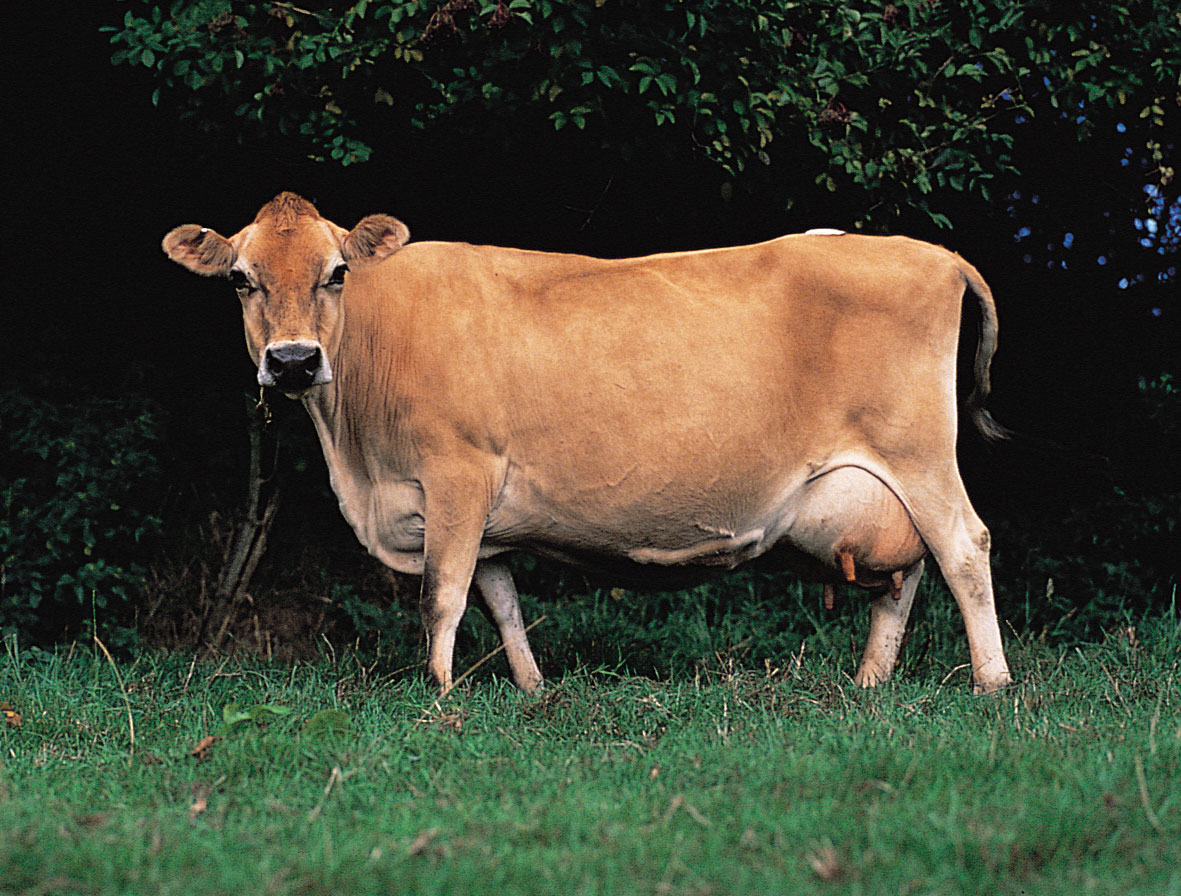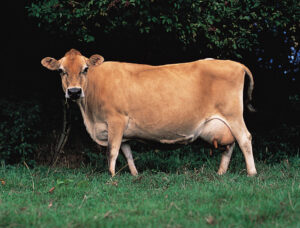The Jersey breed of dairy cattle is a small-sized breed known for its high-quality milk production. Originating from the Channel Island of Jersey, the breed has gained popularity worldwide due to its unique characteristics and exceptional milk composition. In this article, we will explore the various characteristics of the Jersey dairy breed, including its physical appearance, milk production capabilities, adaptability, and historical significance.
Physical Appearance
The Jersey breed is easily recognizable by its distinct appearance. These cows are relatively small in size compared to other dairy breeds, with mature cows weighing between 800 and 1,200 pounds (360-540 kg). They have a fine bone structure, a refined head with bright eyes, and a docile temperament. The coat color of Jerseys can vary from light gray to dark fawn, with white markings on the face and lower body.
Their small size makes Jerseys well-suited for grazing in hilly or rough terrains. They are agile and have strong legs, allowing them to navigate uneven ground more easily than larger breeds. The compact body structure of Jerseys also makes them efficient grazers, as they can reach and consume grass in areas that might be inaccessible to larger cows.
Milk Production
One of the most significant characteristics of the Jersey breed is its exceptional milk production capabilities. Although Jerseys produce less milk volume compared to larger dairy breeds, their milk is renowned for its high butterfat and protein content. Jersey milk typically contains around 4-5% butterfat and 3.5-4% protein, making it ideal for the production of butter, cheese, and other dairy products.
The high butterfat content of Jersey milk contributes to its rich and creamy texture, making it highly sought after by consumers and dairies alike. Additionally, the smaller fat globules in Jersey milk make it easier to digest compared to milk from other breeds. This characteristic is particularly advantageous for individuals who are lactose intolerant or have difficulty digesting regular cow’s milk.
Jersey cows are known for their longevity in milk production. They have an average productive life of 7-8 years, with some exceptional individuals continuing to produce high-quality milk well into their teens. This extended productive life is attributed to their hardiness and adaptability, as well as their natural tolerance to various climates.
Adaptability
The Jersey breed has proven its adaptability to a wide range of climates and management systems. Originally bred in the mild and temperate climate of Jersey Island, these cows have spread to different parts of the world and have successfully adapted to diverse environmental conditions.
Jerseys can thrive in both hot and cold climates, displaying a remarkable ability to regulate their body temperature. Their small size and fine hair coat enable them to dissipate heat more efficiently in warm climates, while their adaptability to cold weather is attributed to their dense hair coat and efficient metabolism.
Moreover, Jersey cows are well-suited for various management systems, including pasture-based grazing and confinement systems. Their grazing efficiency and ability to extract nutrients from lower-quality forage make them ideal for grazing-intensive systems. In confinement systems, Jerseys exhibit calm and docile behavior, allowing for easier handling and management.
Historical Significance
The Jersey breed has a rich historical significance and has played a vital role in the development of the modern dairy industry. Originating from Jersey Island, located between England and France, the breed was selectively bred over centuries to adapt to the island’s unique environmental conditions.
During the 18th and 19th centuries, Jersey cattle were exported to various parts of the world, including the United States, where they gained popularity for their milk quality and adaptability. The breed’s ability to produce high-quality milk on marginal lands made it particularly valuable in areas with limited resources.
Today, the Jersey breed continues to have a significant impact on the dairy industry worldwide. Its genetic traits, including high butterfat and protein content, have been incorporated into crossbreeding programs with other dairy breeds to enhance milk quality and production efficiency. The popularity of Jersey milk and its products has also led to the establishment of specialized dairy operations focused solely on the production of Jersey milk and its derivatives.
Conclusion
The Jersey breed of dairy cattle possesses several distinct characteristics that have contributed to its popularity and success in the dairy industry. From its physical appearance to its milk production capabilities, adaptability, and historical significance, the Jersey breed stands out as a unique and valuable asset for dairy farmers and consumers alike.
With their small size, exceptional milk composition, and ability to thrive in diverse climates, Jerseys continue to make a significant impact on the global dairy industry. Whether it is their adaptability to various management systems or their historical reputation for high-quality milk, the Jersey breed exemplifies the qualities that dairy farmers and consumers appreciate.
FAQs
1. What is the average milk production of a Jersey cow?
The average milk production of a Jersey cow is around 13,000 to 15,000 pounds (5900-6800 kg) per year. However, individual cows can produce significantly more or less depending on factors such as genetics, nutrition, and management practices.
2. Are Jersey cows suitable for small-scale dairy farming?
Yes, Jersey cows are well-suited for small-scale dairy farming. Their smaller size, docile temperament, and efficient grazing capabilities make them ideal for smaller operations with limited resources.
3. Can Jersey milk be consumed by individuals with lactose intolerance?
Yes, Jersey milk is often recommended for individuals with lactose intolerance. The smaller fat globules in Jersey milk make it easier to digest, and the lower lactose content compared to regular cow’s milk may be better tolerated by individuals with lactose intolerance.
4. How long do Jersey cows typically live?
Jersey cows have an average lifespan of 10-12 years. However, with proper care and management, some cows can live well into their late teens.
5. What are the advantages of crossbreeding Jerseys with other dairy breeds?
Crossbreeding Jerseys with other dairy breeds can result in offspring that inherit the desirable characteristics of both breeds. This can lead to improved milk production, milk composition, and overall production efficiency in the offspring.
Summary
The Jersey breed of dairy cattle is a small-sized breed known for its unique characteristics and exceptional milk production capabilities. With their distinct physical appearance, high butterfat and protein content in milk, adaptability to various climates and management systems, and historical significance, Jerseys have become a valuable asset in the global dairy industry.
Despite their smaller size, Jersey cows continue to make a significant impact on milk production and quality. Their adaptability to diverse environmental conditions and ability to produce high-quality milk on marginal lands have made them a preferred choice for many dairy farmers worldwide. The popularity of Jersey milk and its products has led to the establishment of specialized dairy operations focused solely on the production of Jersey milk and its derivatives.
Whether it is their historical reputation, exceptional milk composition, or adaptability, the Jersey breed exemplifies the qualities that dairy farmers and consumers appreciate. From small-scale dairy operations to large commercial farms, Jersey cows continue to contribute to the success and growth of the dairy industry.



